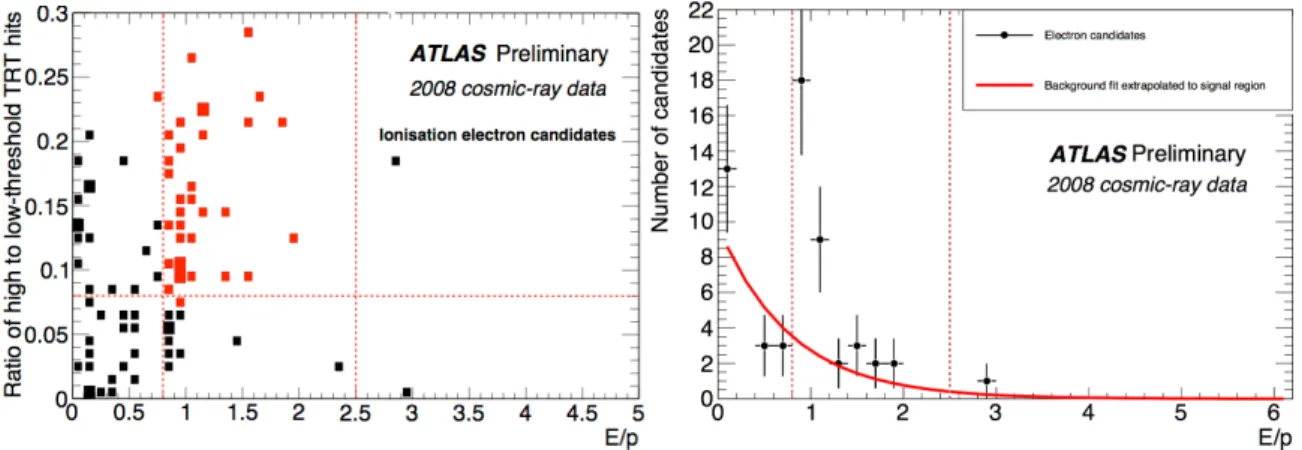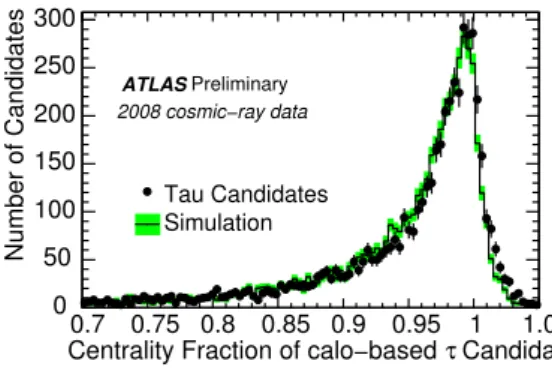with Cosmic Rays in ATLAS
Oliver Kortner on behalf of the ATLAS collaboration ∗
Max-Planck-Institut für Physik, Föhringer Ring 6, 80805 München, Germany E-mail: Oliver.Kortner@CERN.CH
Efficient identification of charged leptons will be a key to the study of many physics processes at the Large Hadron Collider (LHC). The ATLAS detector at the LHC has excellent charged lep- ton identification capabilities. In the years 2008 and 2009, 300 million cosmic ray events were recorded by the ATLAS detector. These data were used to fully commission the muon identi- fication algorithms, to prove the power of the electron identification algorithm and to partially commission the τ lepton identification.
XXth Hadron Collider Physics Symposium November 16 – 20, 2009
Evian, France
∗
Speaker.
PoS(HCP2009)009
1. Introduction
The Large Hadron Collider (LHC) is designed to collide protons at a centre-of-mass energy of 14 TeV with a luminosity between 10 33 cm −2 s −1 and 10 34 cm −2 s −1 [1]. Many physics processes which have been out of reach at previous colliders will become accessible by the LHC. These processes range from the production of the Higgs and new gauge bosons to the production of superpartners of the known fundamental particles. All of them, however, are highly obscured by QCD reactions. The QCD reactions are usually accompanied by multiple jets in the final state and leptons of low transverse momenta. Many of the interesting non-QCD processes can be detected in final states with charged leptons of high transverse momenta. For the last years, one of the core activities of the ATLAS collaboration has therefore been the optimization of the charged lepton identification.
The ATLAS detector has recorded millions of cosmic ray events since fall 2008 with two major cosmic ray recording periods, one right after the LHC accident in fall 2008, the other in summer 2009. In fall 2008 216 million cosmic ray events were recorded with different detector configurations. About 20 million events were recorded with the magnets turned on. These data were used to study the performance of the electron, muon, and τ lepton identification algorithms.
In summer 2009 additional 93 million events were recorded, in the first half of the data taking period with the magnets turned on, in the seond half with the magnets turned off. The summer 2009 data were heavily used to improve the muon performance. 20 million events without magnetic field made it possible to align the ATLAS muon spectrometer.
The ATLAS detector is located about 100 m underground. Mainly muons which fly through the access shafts to the ATLAS cavern are detected by the ATLAS detector while the others are absorved in the rock formation above the ATLAS cavern. So most of the muons are vertical and only traversing the entire ATLAS detector in the barrel part. That restricts the commissioning of the identification algorithms to barrel region. The energy spectrum of the recorded muons peaks at low momenta as usual for cosmic rays, but there is a substantial fraction of events with high p T muons up to transverse momenta of 100 GeV.
2. Commissioning of the muon identification with cosmic rays
The availability of muons up to 100 GeV energy in cosmic rays makes it possible to commis- sion and study muon identification in great detail.
The ATLAS detector is equipped with a high resolution muon spectrometer in which three layers of muon chambers are used to measure the muon trajectories and momenta. In order to get the muon momentum at the proton-proton interaction point the energy measured in the muon spectrometer is corrected for the energy loss of the muon in the calorimeters. Muons which are re- constructed in this way are called stand-alone muons. If the momentum measurement is combined with the momentum measurement in the inner detector, one referes to those muons as combined muons.
Muons with an energy below 3 GeV are absorbed in the calorimeters. Muons with transverse
momenta greater than 5 GeV are indentified with 95% at a low fake rate of about 0.1%. The
inefficiency is caused by acceptance gaps of the muon spectrometer like a crack at 0 rapidity for the
PoS(HCP2009)009
services of the inner detector and the calorimeters. Combined muons have a momentum resolution between 2% and 3% up to 100 GeV transverse momentum (see Figure 1). At higher momenta the resolution gets worse and reaches 10% at 1 TeV. The stand-alone momentum resolution curve coincides with the combined curve at large transverse momentum. So the momentum resolution at high p T is given by the muon spectrometer. The stand-alone momentum resolution has three contributions, energy loss fluctuations at low p T , multiple scattering at intermediate momenta, and alignment and chamber resolution at large momenta.
(GeV) p
T10 10
210
3Resolution (%)
0 2 4 6 8 10 12
Muon spectrometer alone Combined with inner detector
| < 1.0
| η ATLAS
Figure 1: Expected transverse momentum resolution for stand-alone and combined muons in the barrel part of the ATLAS detector [1].
The alignment of the muon spectrometer is crucial for high momentum muons, the alignment of the inner detector already for muons with intermediate transverse momenta. The inner detector is aligned with tracks by minimizing track residuals. The muon spectromter is alignment by a system of optical sensors which monitors relative movements of the muon chambers with respect to each other. The relative positions of the muon chambers have to determined once with straight muon tracks which are available in runs with turned off magnets.
The inner detector was aligned for the first time with cosmic muon tracks in fall 2008. The track residuals in Figure 2 are highly improved by the alignment procedure. They have a width of 30 µ m after the alignment procedure which must be compared to 24 µ m expected for a perfectly aligned inner detector. The alignment accuracy which could be achieved with the available statistics is 18 µ m. If one reconstructs muon tracks in the summer 2009 data with the alignment constants from fall 2008, one obtains residuals with 36 µ m width indicating that the geometry of the inner detector was stable on the level of 20 µ m.
Straight tracks are used for the initial alignment of the muon spectrometer. The apparent sagitta of the straight muon trajectories is of the order of a millimeter before the alignment in agreement with the mechanical alignment accuracy and is shifted to 0 after the alignment. Figure 3 shows the mean values of the apparent sagittas after the alignment with tracks for the chambers in the top half of the barrel muon spectrometer. These are all below 100 µm, but not all within the desired accuracy of 30 µ m. The same analysis shows that the bottom part could be aligned with an accuracy better than 200 µm with the available statistics. Sufficient statistics to reach the 30 µ m goal were collected end of October 2009. The analysis of the new data is work in progress.
In order to measure the muon performance after the alignment of the inner detector and the
PoS(HCP2009)009
x residual [mm]
-0.4 -0.3 -0.2 -0.1 -0 0.1 0.2 0.3 0.4
number of hits on tracks
0 5000 10000 15000 20000
25000 Aligned geometry µm σ=30 µm, µ=-1
MC perfect geometry µm σ=24 µm, µ=0
Nominal geometry µm σ=123 µm, µ=-5
ATLAS Preliminary SCT Barrel
x residual [mm]
-0.5 -0.4 -0.3 -0.2 -0.1 0 0.1 0.2 0.3 0.4 0.5
number of hits on tracks
0 2000 4000 6000 8000 10000
12000 µ=0 µm, σ=36 µm
ATLAS Preliminary SCT Barrel 2009 Cosmic Ray Data 2008 Aligned Geometry
0 12000 10000 8000 6000 4000 2000
2008 Aligned Geometry µ=0 µm, =36 µmσ
number of hits on tracks
−0.4 −0.3
−0.5 −0.2−0.1 0 0.1 0.2 0.3 0.4 0.5 x residual [mm]
Figure 2: (a) Track residuals in the semiconductor tracker before and after the alignment with cosmic muon tracks of 2008 data in comparison with the Monte-Carlo predictions for the perfectly aligned detector.
(b) Track residual in 2009 data after the application of the alignment correction determined with 2008 data.
! .FL1H
! E#$#.DF4
7 ) 8 ( 9 '
>% ! 4! #
! 7**
! 9*
* 9*
7**
F+#>%$8G,/
F+#>%$8G,1 F+#>%$8G,3 F+#>%$8R,1 F+#>%$8R,3
*,86F ! :8'&=
ATLAS 2009 cosmic data
preliminary
desired accuracy
Figure 3: Mean values of the apparent sagittas of straight muon tracks in the top sectors of the barrel muon spectrometer. The muon chambers at η ≈ 0 have η index 1, the chambers at the out ends of the barrel at η ≈ 1 have η index 6.
muon spectrometer, muon tracks mimicking dimuon events are selected. Those muon tracks are split into a bottom part and a top part. The comparison of the top and bottom tracks provides performance measures.
The width of the difference distribution of the momenta of the top and bottom tracks is a mea-
sure for the momentum resolution. The solid triangles in Figure 4 show the achieved momentum
resolution as a function of the transverse muon momentum. Below 100 GeV, the solid triangles
are very close to the stars representing the nominal resolution. A degradation of 20% with respect
to the nominal resolution is observed above 100 GeV. The momenta of the top and bottom tracks
systematically deviate by up to 2% from each as a consequence of the residual misalignment of
the inner detector. But, overall, below 100 GeV the performance is close to nominal. Significant
improvements are expected after the alignment with pp collision data.
PoS(HCP2009)009
[GeV]
p
T1 10 10
2(q/p) σ p x
0 0.05
0.1 0.15 0.2 0.25
ATLASPreliminary Cosmic ’08 Split tracks
Data, full ID Data, Si only Simulation, full ID Split tracks
Data, full ID Data, Si only Simulation, full ID
Figure 4: Muon momentum resolution in the inner detector in cosmic ray events.
The stand-alone momentum resolution is also in agreement with the nominal resolution below 100 GeV transverse momenta, but is significantly degraded at higher p T (see Figure 5). There are two sources of the degradation: firstly the residual misalignment of the muon spectrometer, secondly the limited resolution of the drift time measurement of the muon chambers which is caused by the fact that cosmic muon are asynchronous with the artificial LHC clocks serving as a time reference.
(GeV) p
T10 10
2fractional resolution (%)
0 2 4 6 8 10 12 14 16 18 20
ATLAS preliminary
![Figure 1: Expected transverse momentum resolution for stand-alone and combined muons in the barrel part of the ATLAS detector [1].](https://thumb-eu.123doks.com/thumbv2/1library_info/4013935.1541285/3.892.132.433.316.526/figure-expected-transverse-momentum-resolution-combined-barrel-detector.webp)
![Figure 5: Comparison of the stand-alone muon momentum resolution in cosmic ray events with Monte- Monte-Carlo predictions [2].](https://thumb-eu.123doks.com/thumbv2/1library_info/4013935.1541285/5.892.121.403.537.791/figure-comparison-momentum-resolution-cosmic-events-monte-predictions.webp)

